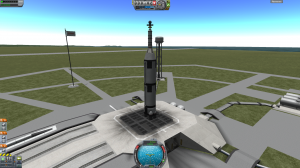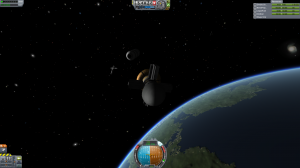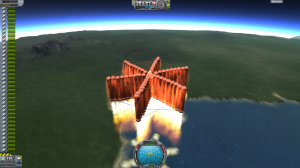This is the story of a bunch of little green people with big dreams. For millennia, the population of the planet Kerbin have been staring at the sky, wondering what mysteries lie up there. Their scientists and philosophers, such as the greats Nicholas Kerman, Galileo Kerman and Stephen Kerman, through observing the motion of the planets and working out the complicated maths involved, worked out the laws of physics governing the skies. But still they dreamed of the day that they could explore the cosmos for themselves.
Then disaster struck the people of Kerbin – for unrelated reasons a massive world war enveloped the previously peaceful Kerbals. When the smoke cleared, one Wernher Von Kerman – an engineer – made a tremendous leap of logic. He was brought in to make weapons of mass destruction, and in order to get them to their target he invented (or rather perfected) a machine called a rocket.
This rocket, he reasoned, could carry things other than explosives. It could perhaps carry Kerbals! In addition, he said, given enough fuel (demonstrated with the help of several blackboards filled with boring equations) you could take them places like those lights in the sky they’ve been enamoured with for millennia!
To show that it would work, the newfangled rocket put a machine in orbit – a fancy thing with a power source and radio antenna and everything! It was somewhat like a lifting up a little moon… an artificial ‘satellite,’ if you will.
This success made anything possible! If one orbit was possible, perhaps with enough fuel they’d be able to reach and land on other worlds – and one nearby target that seemed quite promising was Kerbin’s own moon – The Mun!
Landing Kerbals on the Mun wasn’t the end of their thirst for space exploration, however. In the spirit of international collaboration, they assembled a space station in orbit.
What next awaits the people of Kerbin? Interplanetary missions? Orbital refueling infrastructure? Or will it involve strapping greater and greater numbers of booster rockets to things?
That’s what I thought.







Leave a Reply